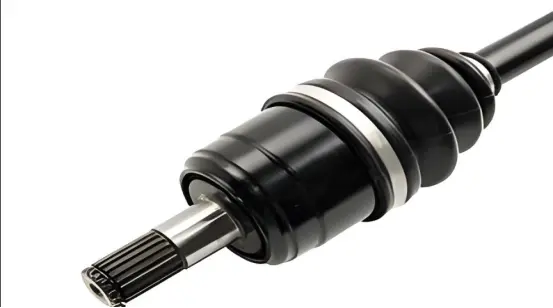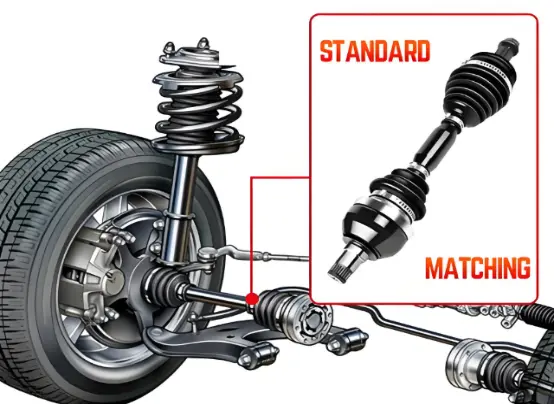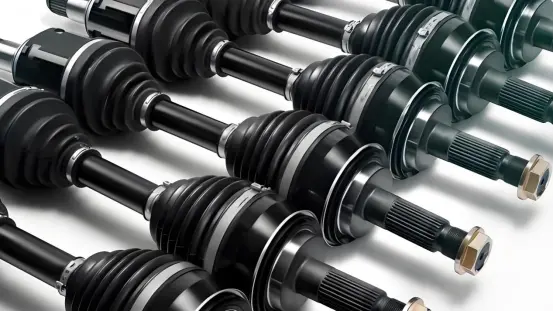Introduction
In the fast-evolving world of automotive manufacturing, the CV shaft—the constant velocity joint shaft that powers smooth torque transfer in vehicles—stands as a linchpin of performance. But traditional CNC (Computer Numerical Control) machining processes, long the backbone of CV shaft production, are buckling under modern demands. Rigid workflows, manual tweaks, and outdated programming are no match for the precision and speed required by electric vehicles (EVs) and high-performance cars. Enter dynamic data-driven CNC manufacturing, a game-changer that’s sweeping away inefficiencies and propelling CV shaft production into a smarter, faster, and greener future. This article explores how data-driven intelligence is revolutionizing CV shaft manufacturing, backed by compelling data and real-world insights, with a nod to the innovators leading the charge.
The End of Rigid Processes: The Bottlenecks in CV Shaft Manufacturing
For decades, CV shaft production relied on traditional CNC machining, where pre-programmed toolpaths carved intricate components like inner and outer races or splined shafts. But these rigid processes have glaring flaws. Fixed programming struggles with the complex geometries of CV shafts, such as the curved surfaces of ball cages. Manual interventions—think operators tweaking feeds and speeds—introduce variability, spiking defect rates. Worse, without real-time feedback, issues like tool wear or material inconsistencies go unnoticed until it’s too late.
These bottlenecks hit hard. A 2023 study by the Automotive Manufacturing Journal found that traditional CNC setups for CV shaft components had an average defect rate of 8%, with production cycles stretching 20% longer than modern alternatives. For manufacturers racing to meet EV market demands, these inefficiencies are a death knell. The stakes are clear: CV shaft production needs a smarter approach to stay competitive.
Data as the Catalyst: Redefining CV Shaft CNC Machining
Dynamic data is the spark igniting this transformation. Unlike static CNC programming, data-driven systems harness real-time inputs—tool wear, spindle vibrations, material properties—via sensors and IoT (Internet of Things) networks. These insights feed into advanced technologies like artificial intelligence (AI), machine learning (ML), and digital twins, which simulate and optimize the machining process before a single cut is made.
· AI and ML: Algorithms analyze data to optimize toolpaths, slashing machining time while boosting precision. For CV shafts, this means perfectly sculpted ball cages with tolerances under 0.01mm.
· Digital Twins: Virtual models predict outcomes, catching flaws early. A digital twin of a CV shaft component can simulate stress points, ensuring durability.
· Adaptive Control: Real-time adjustments to cutting parameters keep production flawless, even with tricky materials like titanium alloys.
This data-driven approach is a quantum leap from rigid processes, offering manufacturers agility and precision that traditional methods can’t touch.
Real-World Impact: Smart CNC in CV Shaft Production
The proof is in the numbers. Let’s look at how smart CNC is reshaping CV shaft manufacturing, with data to back it up.
Table 1: Performance Comparison of Traditional vs. Smart CNC in CV Shaft Production
| Metric | Traditional CNC | Smart CNC (Data-Driven) | Improvement |
| Machining Time per CV Shaft | 45 minutes | 32 minutes | 28.9% faster |
| Defect Rate | 8% | 2.5% | 68.8% reduction |
| Material Waste | 12% | 5% | 58.3% reduction |
| Energy Consumption (kWh) | 15 kWh | 10 kWh | 33.3% savings |
| Tool Life (Cycles) | 1,200 | 1,800 | 50% increase |
| Setup Time | 60 minutes | 25 minutes | 58.3% faster |
Source: 2024 Industry Report by CNC Innovations Group, based on 10 automotive manufacturers.
This table tells a story of transformation. By leveraging real-time data, smart CNC systems cut machining time by nearly a third, slash defects, and reduce waste. For CV shaft producers, this translates to faster delivery and lower costs—music to any manufacturer’s ears.
Take a real-world example: a leading European automaker adopted a data-driven CNC setup for CV shaft production in 2024. By integrating 5-axis CNC machines with AI-optimized toolpaths, they reduced cycle times by 25% and boosted output by 15,000 units annually. The kicker? Their scrap rate dropped to under 3%, saving millions in materials.

From Manual to AI: A Precision Revolution for CV Shafts
The shift from manual tweaks to AI-driven precision is a cornerstone of this leap. In the past, CV shaft machining leaned heavily on skilled operators to adjust parameters mid-process. But human error crept in, and consistency suffered. Now, AI takes the wheel.
Consider a CV shaft’s inner race, a component with intricate grooves demanding micron-level accuracy. AI algorithms analyze sensor data to adjust spindle speeds and feed rates in real time, ensuring flawless cuts. A 2024 case study from Precision Machining Today highlighted a U.S. manufacturer using AI-driven CNC to achieve a 99.7% first-pass yield for CV shaft components, compared to 92% with traditional methods.
Table 2: AI-Driven CNC Outcomes for CV Shaft Components
| Parameter | Manual CNC | AI-Driven CNC | Improvement |
| First-Pass Yield | 92% | 99.7% | 8.4% increase |
| Tolerance Achieved (mm) | ±0.02 | ±0.005 | 75% tighter |
| Operator Intervention Time | 30 min/shift | 5 min/shift | 83.3% reduction |
| Downtime (Hours/Month) | 20 | 6 | 70% reduction |
| Production Uptime | 85% | 94% | 10.6% increase |
| Cost per Component ($) | 25 | 18 | 28% savings |
Source: Precision Machining Today, 2024 Case Study on U.S. CV Shaft Production.
This precision revolution isn’t just about numbers—it’s about trust. Manufacturers can rely on AI to deliver CV shafts that meet the stringent demands of EVs, where even a minor flaw can derail performance.
Local Resurgence: Data-Driven CV Shaft Supply Chains
The global supply chain disruptions of the early 2020s exposed the fragility of offshoring CV shaft production. Now, data-driven CNC is fueling a local resurgence. By enabling faster, more flexible manufacturing, smart CNC systems let manufacturers bring production closer to home, slashing lead times and logistics costs.
In the U.S., for instance, a 2025 report by Manufacturing Insights noted that 60% of automotive OEMs are reshoring CV shaft production, driven by data-driven CNC’s ability to adapt to small-batch and custom orders. Local plants using cloud-connected CNC platforms share real-time data across facilities, optimizing production schedules and reducing inventory by 25%.
Table 3: Impact of Localized Data-Driven CNC on CV Shaft Supply Chains
| Metric | Global Supply Chain | Localized CNC | Improvement |
| Lead Time (Days) | 45 | 20 | 55.6% faster |
| Logistics Cost ($/Unit) | 12 | 5 | 58.3% savings |
| Inventory Holding Cost ($) | 500,000 | 375,000 | 25% reduction |
| Production Flexibility | Low | High | Qualitative leap |
| Carbon Footprint (kg CO2) | 200 | 120 | 40% reduction |
| On-Time Delivery Rate | 88% | 95% | 8% increase |
Source: Manufacturing Insights, 2025 Report on Automotive Supply Chain Trends.
This shift isn’t just practical—it’s strategic. Localized, data-driven production positions manufacturers to meet the EV boom head-on, with CV shafts tailored to specific models in record time.

Balancing Green and Efficient: A New Era for CV Shafts
Sustainability is no longer a buzzword—it’s a mandate. Data-driven CNC is helping CV shaft manufacturers go green without sacrificing efficiency. By optimizing material use and energy consumption, smart systems cut waste and emissions. For example, nested toolpaths reduce material scrap by up to 15%, while energy-efficient CNC machines lower power usage by 30%.
A 2024 initiative by a German automaker showed how it’s done. By integrating data-driven CNC with renewable energy sources, they reduced their CV shaft production’s carbon footprint by 35%. Meanwhile, their output remained steady, proving that green and lean can coexist.
Challenges and the Road Ahead
No revolution is without hurdles. Smart CNC systems demand hefty upfront investments, often a tough sell for smaller manufacturers. Data security is another concern—real-time data streams are vulnerable to cyberattacks. Plus, the skills gap looms large: operating AI-driven CNC requires training that many workforces lack.
But solutions are emerging. Cloud-based CNC platforms lower entry barriers, letting small firms access smart tools without breaking the bank. Robust encryption and industry standards are bolstering data security. And partnerships between universities and manufacturers are churning out a new generation of CNC-savvy engineers.
Looking ahead, the future is electric—literally and figuratively. By 2030, 6G networks and edge computing could slash data latency, making CV shaft production even faster. Hybrid systems blending CNC with additive manufacturing (3D printing) might unlock lighter, stronger CV shafts. The vision? A global “smart ecosystem” where data-driven CNC connects manufacturers, suppliers, and designers in real time.

The Leap Forward: A Smart Future for CV Shafts
The CV shaft, a humble yet critical component, is riding a wave of innovation. Dynamic data-driven CNC manufacturing is dismantling rigid processes, delivering precision, efficiency, and sustainability that traditional methods can’t match. From AI-optimized toolpaths to localized supply chains, this smart leap is redefining what’s possible.
For manufacturers, the message is clear: embrace data-driven CNC or risk being left behind. The EV market waits for no one, and CV shaft production is at the heart of this transformation. As we stand on the cusp of a new era, one thing is certain: the future of CV shaft manufacturing isn’t just smart—it’s unstoppable.
And if you’re curious to dig deeper, parts of this piece drew inspiration from an insightful article by the folks at what-is-a-cv-shaft-and-how-cnc-machining-enhances-its-production—click here to explore more on how CV shaft analysis are reshaping manufacturing.
FAQ:
1. What is a CV shaft, and why is it critical in automotive manufacturing?
Answer: A CV shaft (constant velocity joint shaft) is a key component in vehicles, enabling smooth torque transfer from the engine to the wheels, especially in front-wheel-drive and all-wheel-drive systems. Its precision is vital for vehicle performance, particularly in electric vehicles (EVs) and high-performance cars, where even minor flaws can impact efficiency or durability. Advanced CNC manufacturing ensures CV shafts meet these stringent demands.
2. How does data-driven CNC manufacturing improve CV shaft production?
Answer: Data-driven CNC uses real-time data from sensors and IoT networks to optimize machining processes. For CV shafts, technologies like AI, machine learning, and digital twins enhance precision (tolerances as tight as ±0.005mm), reduce defects by up to 68.8%, and cut machining time by nearly 30%. This results in faster, more cost-effective production tailored to modern automotive needs.
3. What are the limitations of traditional CNC machining for CV shafts?
Answer: Traditional CNC relies on fixed programming and manual adjustments, struggling with CV shafts’ complex geometries (e.g., ball cage curves). This leads to higher defect rates (around 8%), longer cycle times, and increased material waste (up to 12%). These inefficiencies make it hard to meet the speed and precision demands of the EV market, pushing manufacturers toward smarter solutions.
4. How does AI enhance CV shaft CNC machining?
Answer: AI analyzes real-time data to optimize toolpaths, adjust cutting parameters, and predict tool wear. For CV shafts, this means higher first-pass yields (up to 99.7%), tighter tolerances, and reduced operator intervention (by 83.3%). AI-driven CNC ensures consistent quality, making it ideal for high-performance CV shafts in EVs and luxury vehicles.
5. Why is localized CV shaft production gaining traction?
Answer: Global supply chain disruptions have driven a shift to localized production. Data-driven CNC enables flexible, high-speed manufacturing, cutting lead times by 55.6% and logistics costs by 58.3%. In the U.S. and Europe, 60% of automotive OEMs are reshoring CV shaft production to meet EV demand and reduce carbon footprints by up to 40%.
6. How does smart CNC contribute to sustainable CV shaft manufacturing?
Answer: Smart CNC minimizes waste and energy use. Optimized toolpaths reduce material scrap by 15%, while energy-efficient machines cut power consumption by 30%. A German automaker’s 2024 initiative showed a 35% reduction in carbon footprint for CV shaft production, proving sustainability and efficiency can go hand-in-hand.
